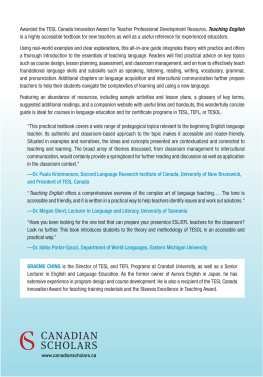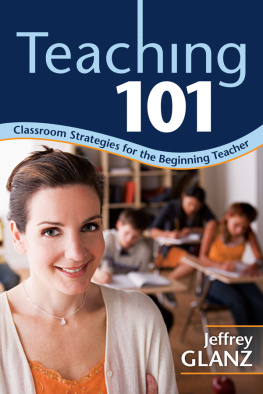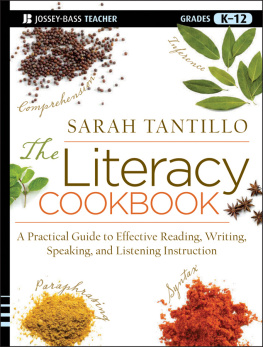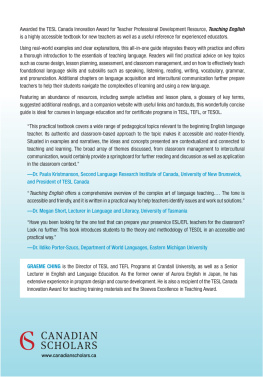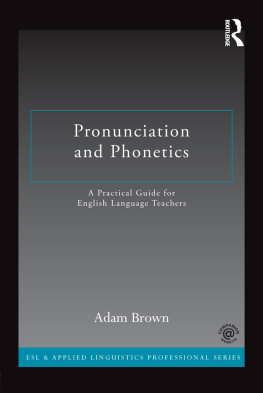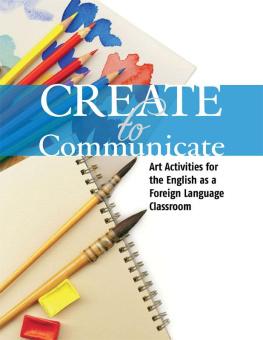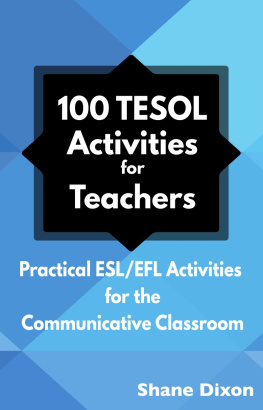
TEACHING ENGLISH
TEACHING ENGLISH
A PRACTICAL GUIDE FOR LANGUAGE TEACHERS
GRAEME CHING

Teaching English: A Practical Guide for Language Teachers
Graeme Ching
First published in 2019 by
Canadian Scholars, an imprint of CSP Books Inc.
425 Adelaide Street West, Suite 200
Toronto, Ontario
M5V 3C1
www.canadianscholars.ca
Copyright 2019 Graeme Ching and Canadian Scholars.
All rights reserved. No part of this publication may be reproduced, stored in a retrieval system, or transmitted, in any form or by any means, without the prior written permission of Canadian Scholars, under licence or terms from the appropriate reproduction rights organization, or as expressly permitted by law.
Every reasonable effort has been made to identify copyright holders. Canadian Scholars would be pleased to have any errors or omissions brought to its attention.
Library and Archives Canada Cataloguing in Publication
Title: Teaching English : a practical guide for language teachers / Graeme Ching.
Names: Ching, Graeme, 1971- author.
Description: Includes index.
Identifiers: Canadiana (print) 20190172460 | Canadiana (ebook) 20190172517 | ISBN 9781773381367 (softcover) | ISBN 9781773381374 (PDF) | ISBN 9781773381381 (EPUB)
Subjects: LCSH: English teachersTraining of. | LCSH: English languageStudy and teaching.
Classification: LCC PE1066 .C45 2019 | DDC 428.0071dc23
Cover design by Liz Harasymczuk

This book is dedicated to language teachers who want to be better at what they do, and to those who want straightforward answers to commonly asked questions.
CONTENTS
This book began as a simple attempt to fill a need. The main textbook that I was using in my TESL/TEFL courses was very good, but a few topics were not well covered, and a few others were not covered at all, so I began writing supplements. To my surprise, my students asked for more, and as the number of supplements grew, I began to joke that it would be simpler to just write a book.
My students agreed. They liked the idea of a book that was well organized, carefully written, and eminently practicala book that was written not for academics but for language teachers in the real world.
And so the journey began.
Years later, and after numerous trial versions and hundreds of updates, the final product is a book that serves primarily as a training manual for new teachers but also as a reference for experienced teachers and administrators. Its objectives are straightforward:
introduce the various contexts in which people learn language and the wide variety of methods used to teach language
consider how learners learn and what conditions best facilitate their learning
provide an overview of course design, lesson planning, class management, and assessment, including current debates on such topics
provide a thorough overview of best practices for teaching language skills (speaking, listening, reading, writing), language subskills (vocabulary, grammar, pronunciation), and content
introduce theory related to language acquisition and intercultural communication
This book does not subscribe to a particular approach to language teaching. Rather, it attempts to give an overview of a wide variety of approaches and methods in order to provide a broad set of tools that a teacher may draw from to meet the needs of a particular class or student. Nonetheless, my personal preferences will at times be evident when I advocate practices that I have found particularly effective.
The book is organized into two parts:
provide an overview of language teaching: What makes a good language teacher? Who are our students and what do we need to know about them? What methods can we borrow from to help with our planning? How do we plan a course? How do we develop lessons and activities? How do we manage the class and assess students progress?
are more specific, addressing language skills, language subskills, linguistic factors in language acquisition, and intercultural communication.
In short, the first part provides a broad base of general knowledge, while the second goes into more detail on specific topics. ( explain how to create lessons and activities related to specific skills or subskills.)
The writing style of this book is aimed at readers who have little or no previous training as language teachers. Relevant terminology is introduced where necessary (to prepare new teachers for further study or discussion of these topics), but academic jargon and unnecessary complexity are deliberately avoided. However, the writing is also unusually compact, so readers are advised not to skim for the general idea but to slow down and discover the many practical ideas offered here that might otherwise be missed.
As noted, this book can be (and has been) used as a reference for experienced language teachers, but it is perhaps best used as a systematic overview for new teachersa broad survey that can be covered reasonably quickly (as a general overview) or more slowly (for more depth on each topic). In my own TESL/TEFL classes, I use the book by applying the same principle found within it: Students learn best by doing. Each topic, therefore, is covered in three steps:
Inform: readings, presentations, and demonstrations
Reflect:discussion, debate, and written reflection
Practice/apply: classroom activities, case studies, curriculum development, and other written or oral assignments
Regardless of how this book is used, my hope is that readerswhether new teachers or seasoned administratorswill find it more helpful and more practical than any book twice its length; if so, I will have accomplished my goal.
Think back to the teachers youve had. Who were your favourites? Why? Were they good teachers or just fun? Did you learn a lot? Were you inspired by their classes? Did they help you believe in your own abilities? What made these teachers different from others?
Most of us believe we can recognize a good teacher when we see one, but when asked what makes a good teacher, we have trouble pinning down the answer. Were more likely to judge one teacher as good by comparing that teacher to another we thought was not so good. Moreover, when we attempt to be good teachers ourselves, we tend to teach the way we were taught, adopting what we believe were good attributes in other teachers while avoiding those we didnt like when we were students.
Is there, then, a right way and a wrong way to teach? Is there only one right way to teach? Are there certain qualities that set some teachers apart? Are some people natural teachers, and if so, is there any hope for the rest of us?
Modelling our teaching on the styles of others is not necessarily a bad idea. After all, we frequently learn by observing what works and what doesnt. Why should learning about teaching be any different? Then again, we are sometimes quick to judge what we see and tend to do so based not on objective criteria but on our own assumptions.
The following provides short descriptions of eight teachers and their teaching styles. How does each compare with your image of what a teacher should be? What are their strengths and weaknesses? What surprises you about their methods, and what ideas might you consider adopting from them?
Next page
